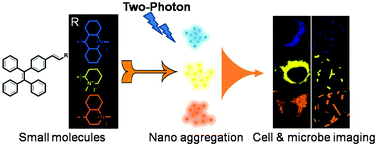Organic nanostructure-based probes for two-photon imaging of mitochondria and microbes with emission between 430 nm and 640 nm†
Abstract
Multi-photon excitation and versatile fluorescent probes are in high need for biological imaging, since one probe can satisfy many needs as a biosensor. Herein we synthesize a series of two-photon excited probes based on tetraphenylethene (TPE) structures (TPE-Acr, TPE-Py, and TPE-Quino), which can image both mammalian cells and bacteria based on aggregation-induced emission (AIE) without washing them. Because of cationic moieties, the fluorescent molecules can aggregate into nanoscale fluorescent organic nanoscale dots to image mitochondria and bacteria with tunable emissions using both one-photon and two-photon excitation. Our research demonstrates that these AIE-dots expand the functions of luminescent organic dots to construct efficient fluorescent sensors applicable to both one-photon and two-photon excitation for bio-imaging of bacteria and mammalian cells.

- This article is part of the themed collection: Nanoscale 10th Anniversary: Top Authors


 Please wait while we load your content...
Please wait while we load your content...